
Last time we looked at the guys that made our lives easier in the garden, this time its the guys that make our lives difficult. Whether you’re a veg grower or you love your ornamentals we all have that moment when we just can’t work out what the hell is going wrong, often until it’s too late!
I’m only going to go over a few of the most common pests here, mainly those that affect our vegetable crops but some will go for ornamentals too! If i tried to tackle them all id end up rewriting the Collins book on P&D!
Cabbage White
Ok this one is being awkward and nestling on some french beans but we all recognise this fluttery pest and we can guess that its prefered victim is members of the Brassica family. Despite its name its babies will happily chow down on broccoli, kale, Cauliflower, Brussel sprouts and Cabbages (and likely more I’ve forgotten).

The trouble with this pest is its one that tugs on our heart strings, it’s a butterfly! Were told to encourage them into the garden, right? Tell me that once you’ve lost an entire crop to them or spent a day squishing the baby caterpillars off your kale! One of the vilest jobs you can ever undertake! Honestly, vile!
So how can we prevent this experience?
Prevention and action really is the key to dealing with this blighter. First protect your crops. creating cages to grow your brassicas under is the ONLY way to go. You need a very fine mesh that allows light and air through but not the butterfly itself. Theres a product on the market called Enviromesh (other suppliers probably do exist) which we used to use at Sissinghurst. I have tried a wider (1cm) netting before but ive seen them push themselves through the gap!

The supports were homemade from canes pushed into the ground then the blue pipe (used to lay water to various taps around the field and water troughs) fitted over them. It worked really well! The mesh needs to be firmly in contact with the ground as the butterflies will find the smallest gap. We had tried various other methods whilst I was there but this was by far the most secure structure.
I revisited recently and a lot of money has been invested in some beautiful cages, which if you have the cash are a gorgeous addition to your plot.
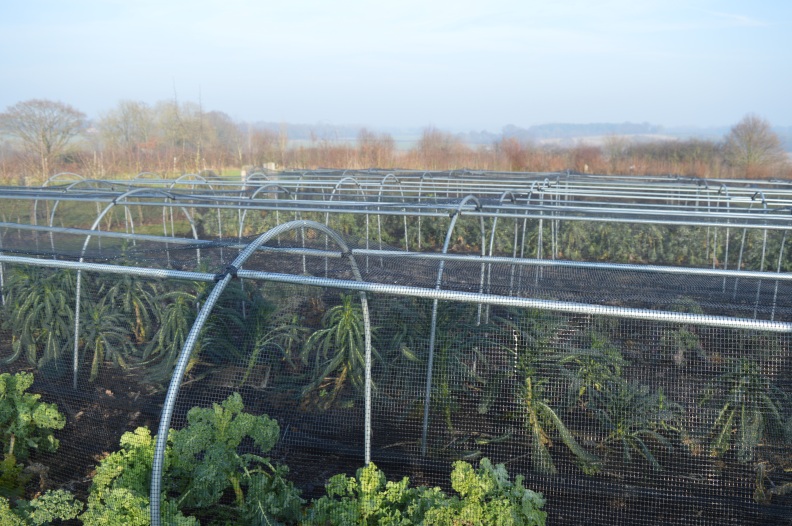
Lets say though your defences havent worked! you can see a butterfly has breached them, the horror!!
First obviously you have to evict them then, and this is the annoying bit, you have to check for eggs…

Above is what we’re looking for, on the underside of leaves, clusters of little yellow cones.
rub them off!
Yes its gross, its icky, im not gonna lie to you but its better you rub them off at this stage than at the next, you have 6 – 10 days max to spot them! The next stage is Caterpillars and by the time you spot them the damage is already done. Squishing Caterpillars is ten times more icky than squishing eggs!
The caterpillars appearance will depend on what type of adult you have, we mainly had the Large Cabbage White (Pieris brassicae) on site but there is also Small cabbage white butterfly (Pieris rapae).
Aparagus Beetle
A cute looking bug really, until you realise the untold damage it can do! Then you’ll want to stamp it out of existence with a hatred bordering on the psychopathic!
You think im joking?
Picture the scene *cue wiggly lines for a flashback* you planted your Asparagus plants out lovingly in ridged rows 2 years ago, patiently waited until that 3rd year before cutting a single spear. The first year they grew strongly, their delicate fronds swaying hypnotically in the breeze. You patiently mulched them that and subsequent winters, resisting the temptation that second spring even though the young spears tempted you sorely with their mouthwatering promise! You did notice a few fronds had died back early but discounted it as maybe wind rock damage until….
This spring as you were bending down to harvest you notice a beetle, an ornately coloured beetle with lovely little domino style spots on its back, lurking near the base of the spears. No matter! You have Asparagus for tea! You cut your spears and head off on your merry way never realising that pretty beetle has already laid its eggs of disaster!
This is the disaster that will befall your poor innocent Asparagus!!
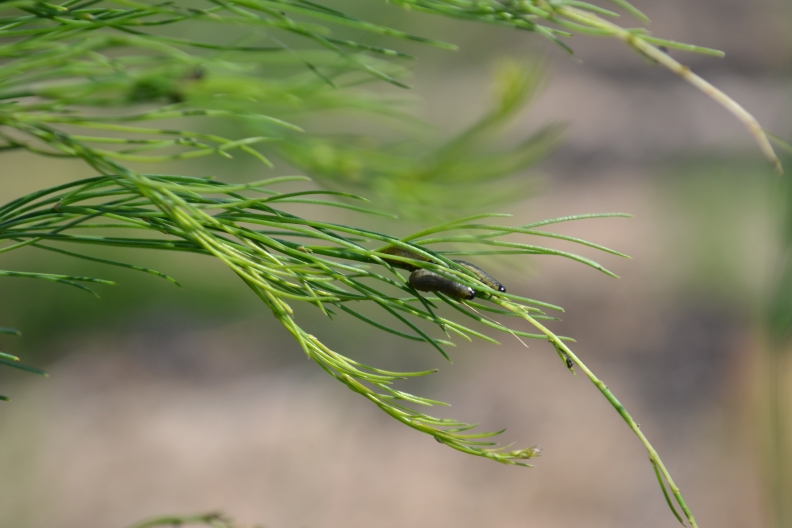
Ok, I may be being slightly overdramatic… a bit… but these guys are so gross its untrue and can strip your asparagus fronds in days and they’re so small you can hardly see them! These are the larvae of the Asparagus beetle, vile creatures!
So what can you do to defend against them?
Know your enemy! First you need to know their habits, their modus operandi!
The adults overwinter in debris and maybe its an unfashionable view at present but im a clean freak when it comes to the veg garden, every dead leaf is a hidey place for these horrors, every unweeded bed a hotel of doom!
They emerge in the spring and head straight for your innocent unprotected virginal spears to munch & gorge themselves on the very flesh of the tenderest tips. Whilst there they viciously deposit eggs with abandon. A single green egg hides amongst the newly emerging fronds practically impossible to see, within a week the vile buggers have hatched and are munching their way to the top heading for the berries but causing untold damage along the way. In just 2 short weeks the damage is done and the larvae drop to the ground to borrow into the soil where they pupate, emerging just 10 days later as adults to continue feeding!
I’m not sure what I hate about them the most, the damage they do to your beautiful Asparagus, weakening it and sometimes killing off or the mess they leave behind whilst feeding! Theres a special term for bug poop, which I don’t think quite captures the revulsion I feel upon encountering it, the term if ‘Frass’.
If you grow Asparagus here’s what the adults look like…
Controls
As stated in the first post on bugs, Bugging out! The good guys… the best controls are from your natural predators, ladybirds, lacewings and birds in this case will all feast on Asparagus beetles & their larvae, so put down that spray bottle!
Your next line of defense comes from cultural controls, good plant husbandry. At the end of the season clear that years debris thoroughly leaving no hiding places for overwintering adults. Avoid composting old fronds, instead remove off site or if possible burn, the ash from your burnings can be spread thinly on the soil to add potassium. This will encourage good root growth and fruit set next season or incorporate that into your compost heap.
Whilst harvesting check thoroughly the newly emerging fronds for adults or eggs and squish mercilessly!
To our next predator of plants…
Sawflys
There are a number of these guys that answer to the name of Sawfly, some predate fruit, some veg, others will have a go at your ornamentals. In all case a damned good squishing is called for.
Below is the Gooseberry Sawfly, sitting on my secateurs for scale.

He’s not a massive chap is he, you could pretty much blink and miss him…. until you turn round one day to find not a single leaf left on your gooseberries (or red & white currants which they are quite happy to decimate as an alternative).
Take note of the legs on the sawfly larvae above, caterpillars don’t have legs as such they have something called prolegs which are stumpy little sucker like things but Sawfly larvae tend to have well developed legs. This is a good way of identifying them separate from butterflies & moths.
Another interesting fact about Sawflies is the populations are predominantly female, males are not even needed for procreation!
The Gooseberry Sawfly is who we will concentrate on here though.
It can produce up to 3 generations per year so breaking its cycle is of paramount importance otherwise your bushes will never recover. The larvae will begin to appear in April, feed, pupate, emerge, lay eggs & can carry on till September where the last batch will drop to the ground below, burrow in and pupate till next spring.
Controls
I’m rarely if ever going to recommend a chemical control when there are so many easy and better methods to control pests such as this. You have your natural predators, the handy little guys that have got your back but with vast numbers we need to give them a helping hand. It’s just not viable in some cases to squish each single larvae by hand though is it. Youd be there hours!
I have a cunning plan…
Grab yourself an old dustsheet/bedsheet/ newspapers etc. anything you can spread around the base of the plant, completely covering the ground underneath your bush. Get yourself a soft brush (like the type that comes with a dustpan) and starting from the top of the bush working your way down carefully through the levels brush both the top and the bottom of the leaves carefully with enough force to dislodge the nasty little crawleys onto your dustsheet below.
Now comes the slightly gross bit, quickly as they can move with surprising speed, fold the dustsheet in on itself, collecting them in the middle with no means of escape. You have 2 choices at this point you can take them far, FAR away from any form of sustenance & shake the sheet out in the hope that birds will swoop down & devour them. This does of course run the risk that they may find their way home or onto a neighbours bushes which wont go down at all well
OR
And this is my preferred method. Take the sheet to some hardstanding…. AND STAMP ON IT!!
REPEATEDLY!!
I realise this is a bit of a stomach churner for some of you but once you’ve witnessed the damage they can do in such a short time you may feel differently. I’m a great believer in the size 9 as a form of pest control.
How else can you break the cycle?
This ones easy. Around the base of your plants you need to create a barrier so the larvae are unable to burrow into the soil to pupate. You have several options open to you to do this. A permanent solution is to put down a weed suppressant membrane.
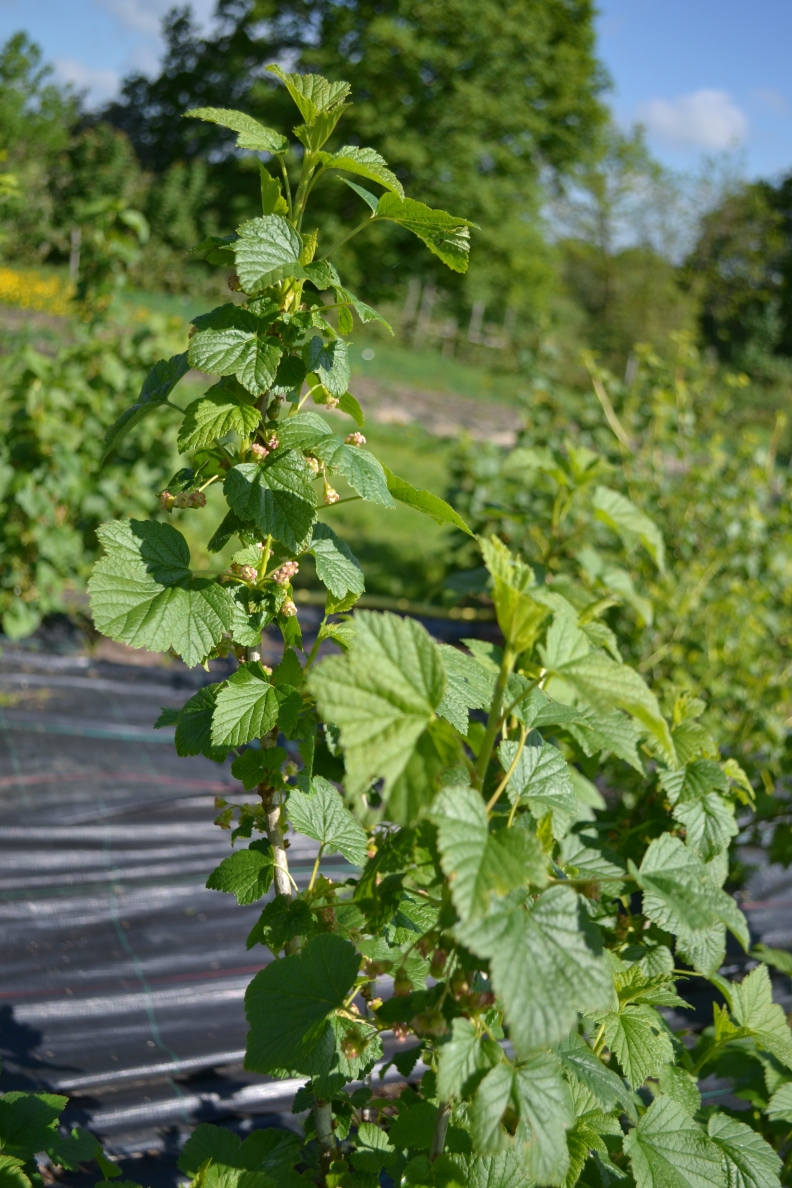
This has certain advantages regarding the fact it stops the larvae and stops weeds but I have a slightly different solution which is cheap easy and allows for a feed of compost/manure to be applied during the winter months. Brown cardboard and straw. The cardboard creates a barrier the larvae are unable to penetrate, the straw acts as a moisture retentive mulch & looks prettier than the cardboard. At the end of the season this can be lifted and added to your compost heap, allowing birds to come and pick the ground clean and you to add well rotted manure to the base of the plants during the winter months.

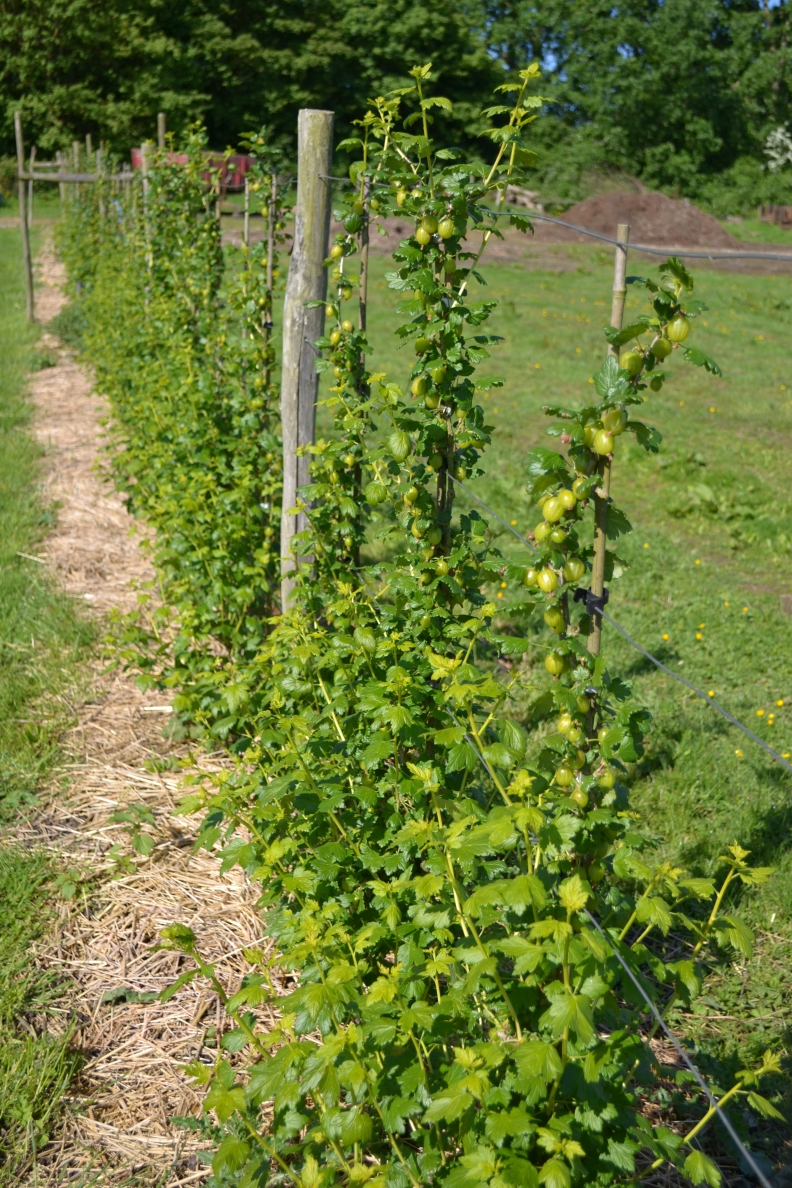
Its worth, at this point mentioning Rose sawfly as it was very active last year. The rules are very similar to those of the Gooseberry sawfly, here’s what you’re looking for…

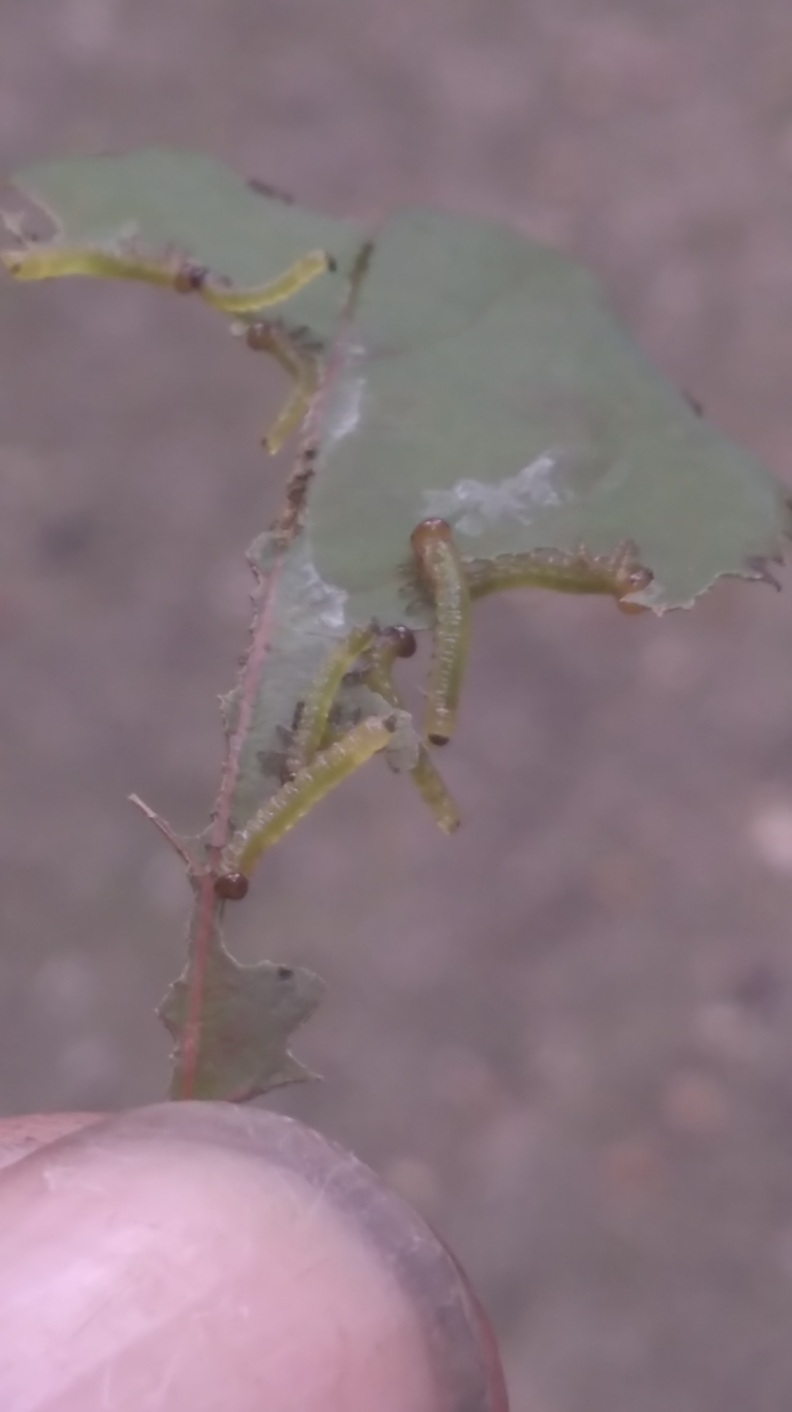
This is likely to be Arge ochropus, the rose sawfly but there is another rose sawfly which honestly I couldn’t spot the difference without a book and a magnifying glass called Arge pagana. The adult rolls young leaves into a cocoon and lays her eggs.

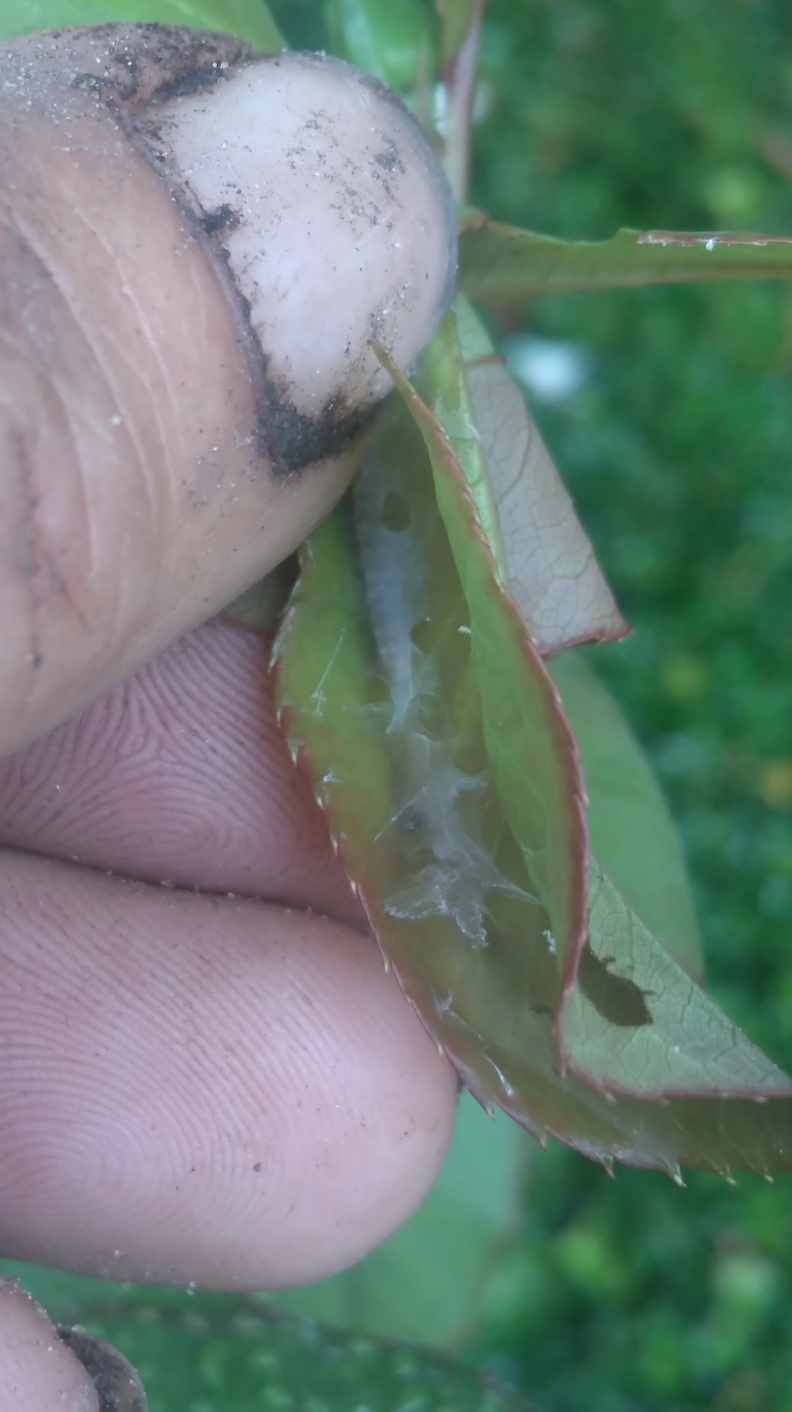
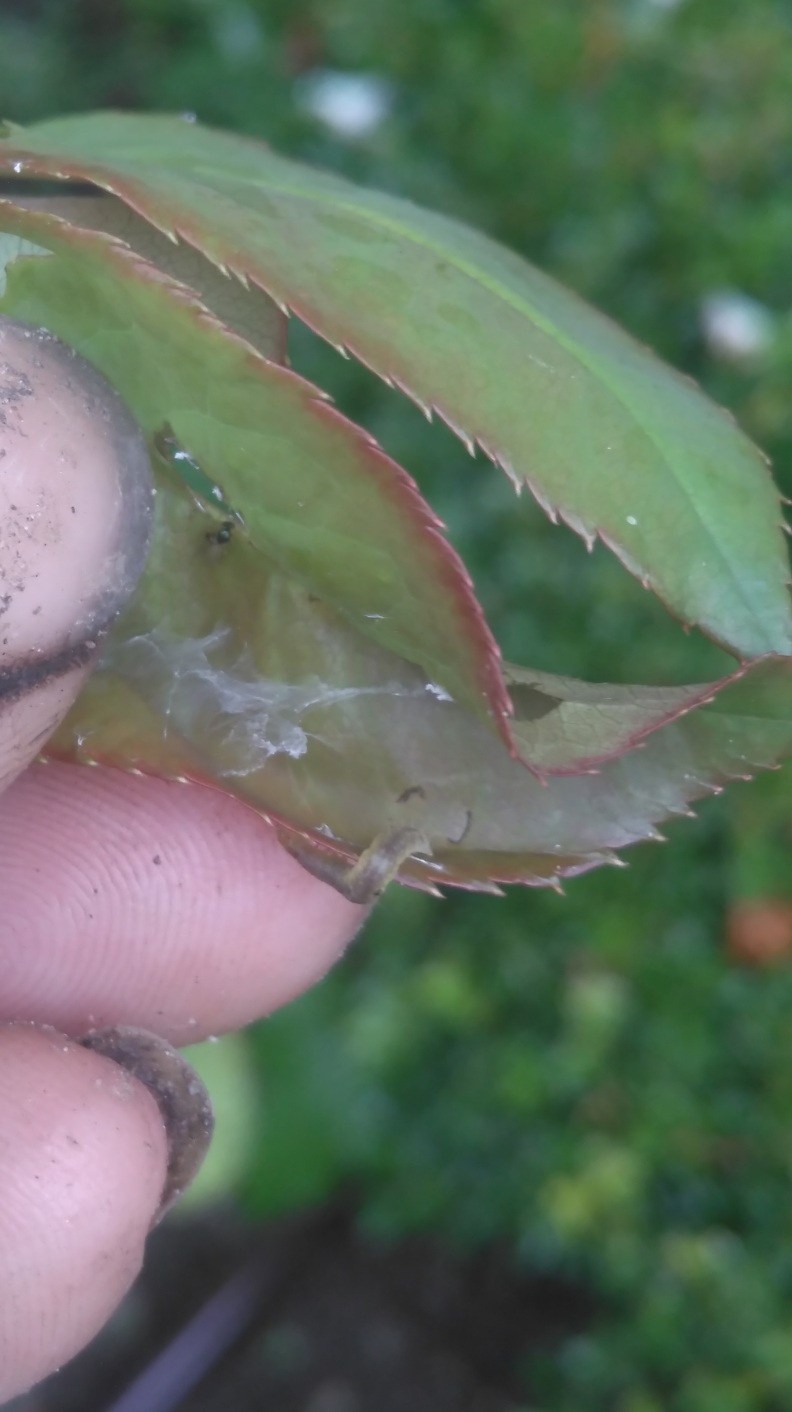
Which then munch their way out defoliating your rose as they go. Vigilance is a must for dealing with these guys!
Next up on our most (or least) wanted list is….
Chafer grubs
This is one I often see misidentified on internet forums, given its size it’s actually one of the easiest! ITS HUGE!!


What does this monster grow into though? This is where i become slightly reluctant to squish as in reality you’ll be very lucky to see its adult form and numbers have declined sharply in recent years. This monster larvae grows up to be the famous Cock Chafer!!

Ok, youve stopped sniggering now, right?
But look at him he’s so cute!! He’s a furry beetle!! How can I tell you he’s a harmful beastie in his larval form!
Ahem, I remind you! MONSTER!!
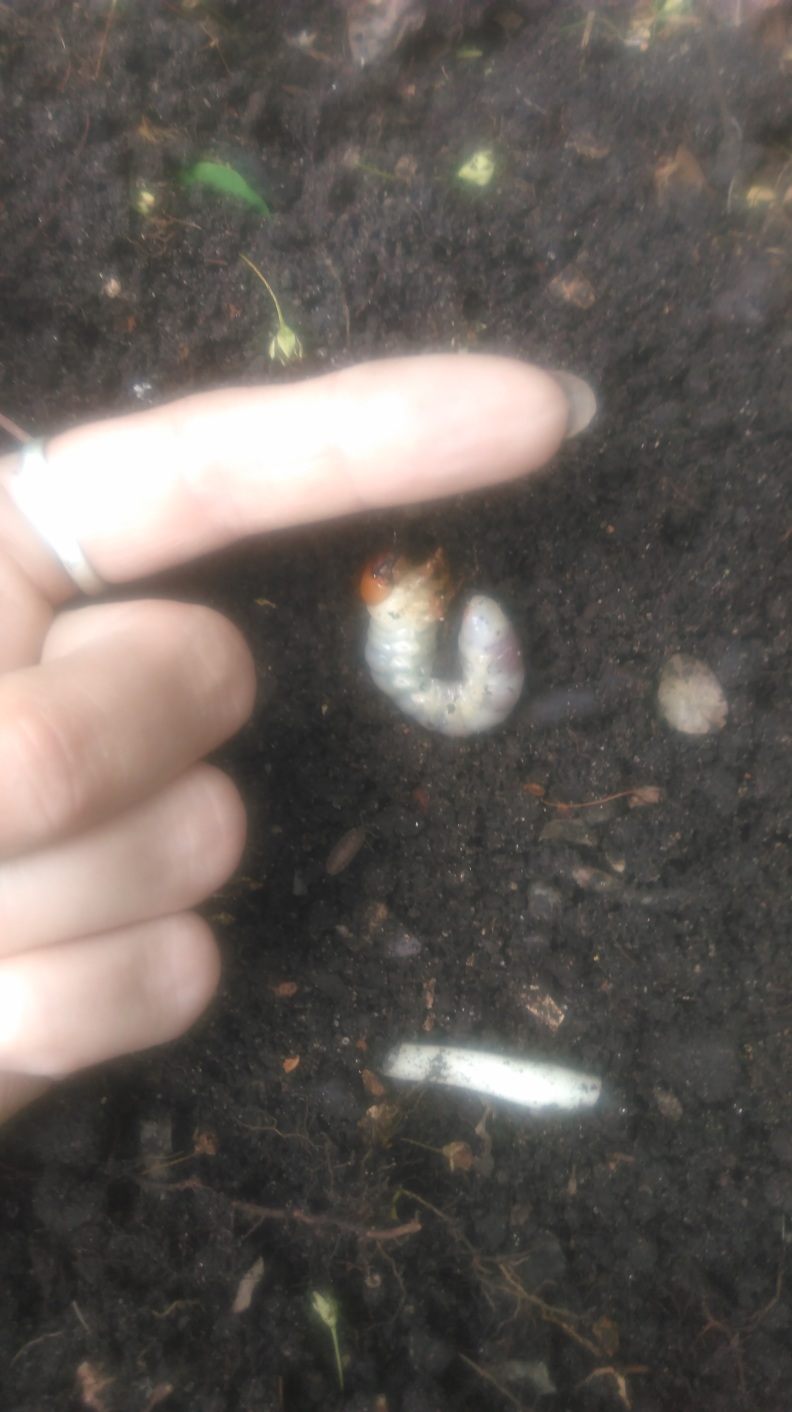
As a larvae Mr Cock Chafer will munch his way through the roots of your plants and as they spend 3 -4 years of their lifecycle in this form they can do untold damage to a confined area. Before pesticide usage nearly exterminated them completely they were something of a problem. In 1911 swarms of Chafer beetles numbering in their 1000’s were reported! We are unlikely to ever experience this in our lifetime, I have only seen 3 in my entire life, one of which flew past my ear into my kitchen one warm May night with the downdraft and sound of a landing Chinook. Scaring the life out of me & both my cats, who ran for cover leaving me to evict this flying behemoth by myself…. useless cats!
This brings me neatly to the fact I can easily remember easily it was the month of May, how? The adults alternative name is May bug as they emerge from the soil in the month of May and start their short lived quest to find a mate. They live in this form for only 5-7 weeks during which time they mate and the female will lay 3-4 clutches of eggs.
Another weird fact about these critters is they were once such a problem they were put on trial! Yep, on trial…
In 1320, Avignon France they were charged by the courts to cease and desist their activity in nearby fields which was damaging crops and instead remove themselves to a designated field where they would be allowed to live unmolested. The cock Chafers of course have no respect for the law and continued doing what Cock chafers do…. The court enforced its orders by sending people out to collect and kill them.
So what to do, how to deal with this if you come across one?
For once im NOT going to tell you to squish it, pick him up and find a hedgerow, a bit of unloved turf in your local area, somewhere he can feed and complete his lifecycle unharmed and very gently rebury him (don’t pat the soil down after, you’ll end up squishing his soft little body!). He’s struggled enough against pesticides he deserves a break and I’d love for kids of the future generations to get excited at seeing MAHOOSIVE beetles buzzing round their gardens!
This brings me neatly to the pest which the Cock Chafer is usually mixed up with (for the life of me I don’t understand how this works, as you shall see!)
Vine weevil
As a kid I would see the adults of these crawling up walls, on plants etc. Not knowing what they were (except that I didn’t like the look of them) I named them Wood bugs as they looked like they were carved from wood & had a great resistance to squishing. Unlike beetles, weevils have a pointy snout and now as an adult im always reminded of my Grandad and him playing me the song ‘Boll weevil’ (https://www.youtube.com/watch?v=Pe-A-I9sjLU) I’ve got a feeling that there’s a subtext to this song when I listen to it as an adult *cringes given the current political climate* but as a kid it was just a funny song …. anyway! back on track!
Vine weevils do not get the same stay of execution chafer grubs do. For me its all out war on both the adults and the grubs. The attack the choicest, rarest plants in your collection. Zero’ing in on your most beloved of babies, fact!
Ok maybe I exaggerate but it does feel that way. The books will tell you they only attack certain plants but in my experience they will have a good go at anything especially if it’s in a pot. All Vine weevils are female, another example in the bug world where males are redundant, sorry guys! They emerge as adults able to reproduce without the need to waste precious time finding a mate. They cannot however swim or fly! So I guess there are a few checks on their quest for world domination. Smooth glazed pots foil their attempts to climb and plants sat in saucers of water also foil these voracious plant predators.
Heres what the adults look like… Adult Vine Weevil
and the grubs… Vine weevil grubs
But below as a comparison for size and also a freaky anomaly of the Vine weevil I caught in its transitional stage from grub to adult with my secateurs for scale.

Compared to the chafer grub it is miniscule! Also I’m pretty sure that this is what the monster from Alien was based on as close up… well judge for yourself…

YUCK!!
So if you too are going to call all out war on these guys how can you deal with them?
Control
The unseen enemy! Difficult to combat but not impossible, there are biological controls available. Whats a biological control? isn’t that a detergent? No, even better, this is a bug that will kill your bug for you (no squishing involved!). In this case its something called Steinernema kraussei, snappy name! This difficult to pronounce, harder to remember name refers to the tiny parasitic eel worms which are more widely known as nematodes. They burrow into the grubs and eat them from the inside out! AWESOME!! Even more gruesome a death than being squished.
This biological control is widely available mail order but must be used immediately as obviously your package contains live insects and they need feeding. Its simple to apply just mix the gloopy stuff up with water at the rates directed on the packet and hey presto water it onto your pots, instant controls in place for months.
The adults though can continue feeding and breeding so if you stop ragged notches taken out of your plants leaves have a good search, look on the leaves, the stems and the soil and when you find them give them the order of the size 9!
My last pest (for now) is one which you may not immediately recognise by the damage it does…
Pigeons
Yep that’s right, heres me saying encourage birds into your garden and now im telling you one of them is a pest!
This mainly applies to veg growers but they will in hard times have a peck at new buds on fruit trees, young seedlings etc…. Still they are better than having bleedin peacocks in the garden! Seriously don’t get me started on the damage those arrogant overblown chickens can do! If you’ve ever had the misfortune of working in a garden that’s had bleedin (this is now a permanent prefix) Peacocks you’ll know what I mean… anyway back to the flying rats… sorry pigeons…
You may initially blame the damage on slugs and snails, this blame and doubt will likely only last a week before your crop is gone, completely. As once they realise that you have something they like and it’s not protected they will hammer it! So how can you tell the difference?
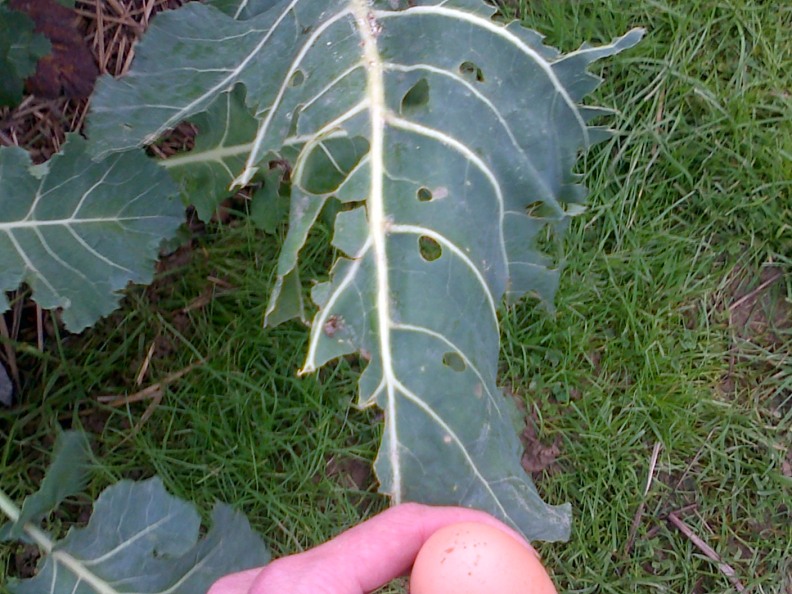
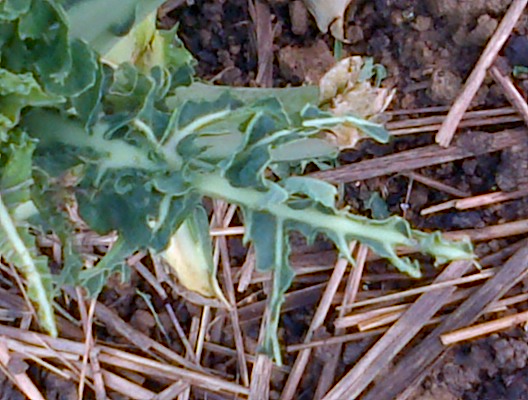
Above are 2 great examples of pigeon damage on brassicas, their preferred crop, notice they tend to peck at the soft bits in between the ribs of the leaf, often leaving the midrib entirely alone. Another clue would be seeing shreds of leaf on the floor around the plant, as they rip sections out with their beaks they will often drop bits, messy eaters!
In the winter especially I would take a walk onto the vegetable garden at Sissinghurst as the sun was rising, this is the time the sneaky buggers would be most active and just the deterrent of a person walking round would be enough to put them (and the errant pheasants) off but this isn’t practicle for most people.
Control
Firstly you need a method of prevention, much like the Cabbage Whites at the start of this piece, netting is your friend! Build cages and net them, pin the nets firmly into the ground. Especially if you can’t check your plot everyday as loose netting can cause deaths. It can catch up songbirds, hedgehogs, rabbits or pigeons and if caught up for days it means certain slow & horrible death.
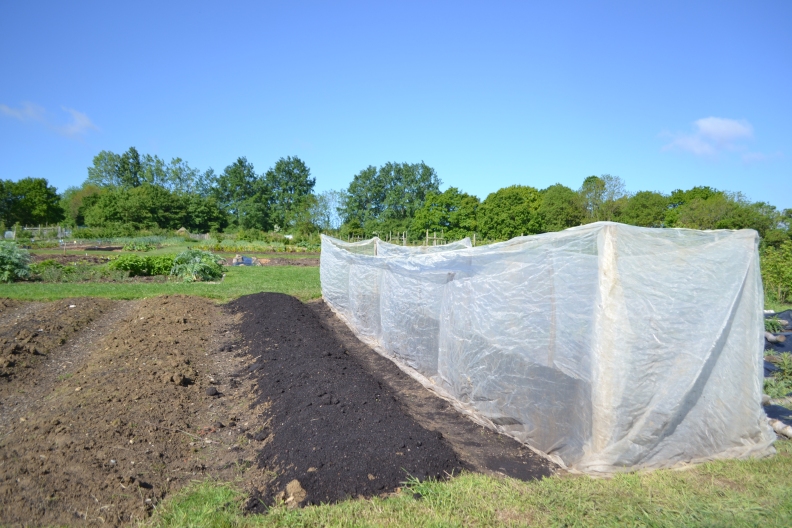
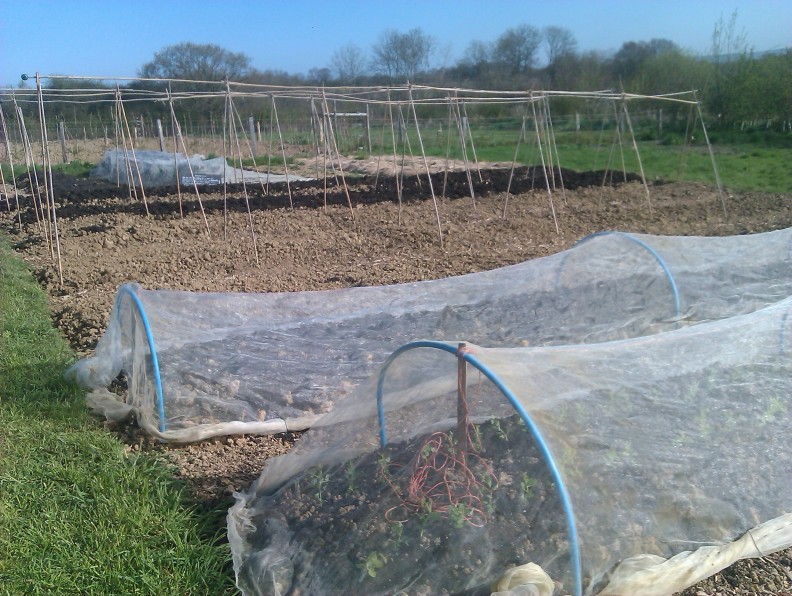
If pinned firmly though it’s the best investment you’ll ever make!
Another cheap and cheerful method is to get hold of some old CDs, string them up above your crops, the shiny surfaces reflect shards of light convincing the birds a predator is creeping up on them!
Ultimately though vigilance and knowing your enemy in all of these things is your best defence.
Good luck in the coming growing year and remember if you’re not sure… well… you can always ask me 😉
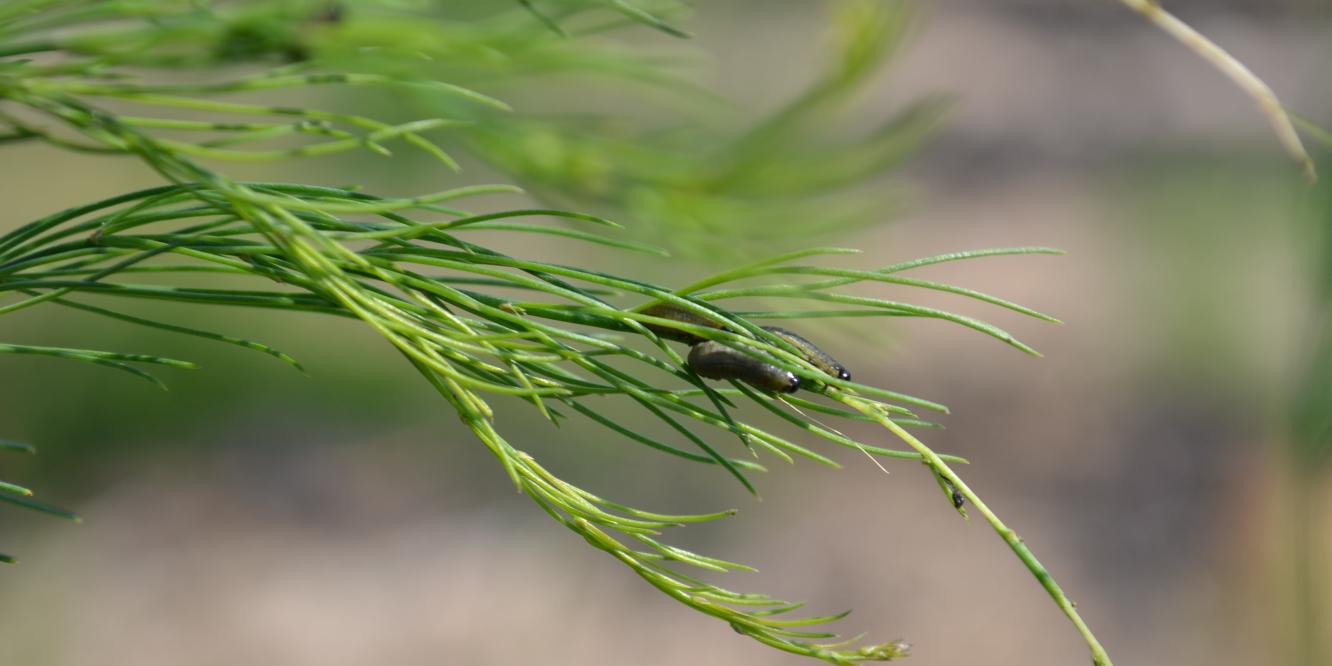
Wow! That is one comprehensive post – more like ‘war and peace’ ! It has reminded me of all the pesky varmints which try to outsmart me in the growing season. My squishing thumb is twitching uncontrollably …
LikeLiked by 1 person
*wails* i know!! there was so many more though!! ;p
LikeLike
Really good post, thanks.
LikeLiked by 1 person
Thank you 🙂
LikeLike
Fab post. My overwintered cabbages have been decimated, I assumed by slugs, but now I wonder if it’s the flipping pigeons? Flying rats. Grrr. I will net up my raised beds this year, once bitten twice shy. Do you have any advice for fungus gnats? I think I have ’em in the heated bench in my greenhouse.
LikeLiked by 1 person
When you say fungus gnats do you mean sciarid fly? Theyre quite distinctive from fruit flys as their wings move in a scissor action. They love heated benches and seedlings as they love warm, damp conditions. If this sounds like your guys then decrease watering as much as you dare, this will encourage your seedlings to build up their root growth in search of moisture and also makes life difficult for the nasty larvae that feed on the roots of your babies. There is a bio control you can mail order and water on which contains a nematode that preys on the larvae. This could help but the temp has to be right. I found yellow sticky traps help and air circulation. Sorry for delay in replying, over enthusiastic spam filter at work, shouldnt happen again!
LikeLike
Could well be yes. Not sure where I got fungus gnats from as a name. Interweb probably. Anyway I had some bug spray in the shed which appears to have done the trick. Not very organic of me but effective. I’ve also fitted a thermostat to the bench so it is less hot, 20 degrees. Maybe that has put them off a bit, if they survived the chemical warfare. Thanks for your reply!
LikeLiked by 1 person
Id never heard them called that before myself but as the link proves its obviously a name thats in use, odd isnt it, you may find youve killed the adults but not the larvae which are the real buggers! I’ll keep my fingers crossed for you but if seedlings look wilty & compost is wet dont give in to the temptation to water. If the cause of the wilt is the larvae, watering will only help its progess, good luck!
LikeLike
Thanks, I think I got em fast enough, no sudden deaths in the heated prop bench.
LikeLiked by 1 person
And yes I do mean sciarid flies, same thing. https://www.rhs.org.uk/advice/profile?PID=804
LikeLike
excellent, then my work here is done 😉
LikeLike
I’ve never seen sawfly on roses (& I hope that I never do!) but I do know that in many of the gardens in which I work, Berberis has taken a pasting over the last few years. Some of my customers have had me resorting to spraying – something I don’t like to do, but on a large shrub, there’s little alternative.
LikeLiked by 1 person
Fingers crossed I hope you never have to either! There are so many various types out there
LikeLiked by 1 person